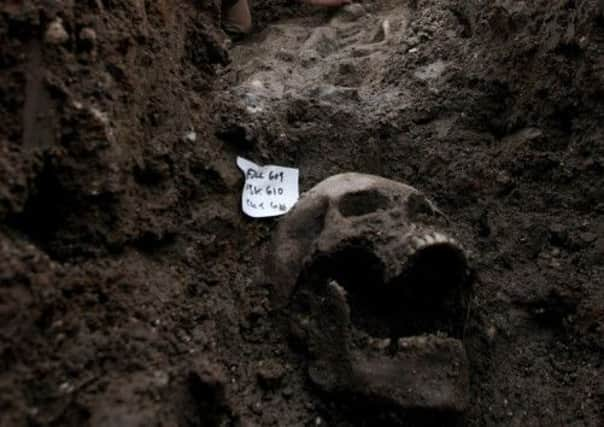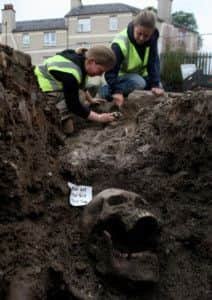Flooring firm sue for £1m over medieval skeletons


• A flooring company is seeking more than £1m in damages after the discovery of a medieval burial ground on a site it had planned to develop on
• Manorgate Ltd claim that when the site in Perth had been purchased they had not been informed of its archaeological designation
Advertisement
Hide AdManorgate Ltd bought the development site on the corner of Riggs Road and Whitefriars Street in Perth, in 2006, unaware that the area was designated a site of archaeological significance.


The company was forced to abandon its development plans after an archaeological dig, ordered by the local council, uncovered more than 100 ancient skeletons at the site of the medieval Friary of Tullilum.
Manorgate is suing property search company, First Scottish Property Services Ltd (FSPSL) for £1.2 million for failing to disclose the site’s archaeological designation while carrying out an “appropriate property search.”
In a judgement issued at the Court of Session, Lord Woolman has upheld the claim and ordered a further hearing for the final compensation figure to be settled.
According to the judgment, Manorgate bought the site for £385,000 in 2006, intending to demolish the existing buildings and erect new commercial premises at the site. One of the new units was to be used as a retail branch for its flooring business, Direct Flooring.
Lord Woolman states: “After Manorgate paid the purchase price and took entry, it discovered a crucial fact. The site was designated as being one of archaeological significance.
Advertisement
Hide Ad“The designation had a major effect on Manorgate’s plans. In granting planning permission to carry out the proposed development, the planning authority required Manorgate to carry out archaeological investigations.
“Those investigations disclosed that a mediaeval Friary with associated burial ground had once stood on the site. Extensive human remains lay below the earth’s surface. The planning authority stipulated that those remains had to be dealt with in a sympathetic manner.”
Advertisement
Hide AdThe judge continues: “There were two main options. The first was to remove the remains by way of excavation. The second was to design the foundations for the new buildings in a manner which did not interfere with the remains. Over a very lengthy period Manorgate considered various solutions with the aid of its professional advisers. Ultimately, it concluded that the development was uneconomic. It closed down the site in March 2010 and it has remained ‘mothballed’ ever since. “
The archaeological designation of the site should have been noted in an appropriate property search. But FSPSL, who carried out the search had provided a Property Enquiry Certificate (PEC) which failed to disclose the archaeological designation.
Lord Woolman states: “FSPSL admits that it was negligent. It accepts that the PEC should have referred to the archaeological designation. But it maintains a number of lines of defence. They include causation, contributory negligence, remoteness and mitigation. In my view, these lines of defence fall to be rejected and the real question is the proper calculation of Manorgate’s loss. “
According to the judgement, the Friary of Tullilum was established in the 15th Century by Carmelite monks and thrived until the 16th Century.
The judgment notes that over the course of the years the Friary fell into disuse and its buildings became derelict. By Victorian times, no visible evidence of the establishment remained.
“Despite the name of the adjacent thoroughfare (‘Whitefriars Street’), in modern times many people were unaware of the Friary’s existence,” the judgment states. “They included the sellers from whom Manorgate acquired the site. Its history was, however, known to some individuals. The Ordnance Survey map of 1862 identified the area as being the supposed site of a Whitefriars Chapel.”
Advertisement
Hide AdIn 1982 archaeologists carried out limited excavations in the area of the site and confirmed the existence of the Friary. They also discovered the remains of 21 people and concluded that the site incorporated a burial ground. But archaeologists were unable to determine the exact configuration of the buildings, nor did they know the precise location or dimensions of the burial ground.
After Perth and Kinross Council ordered an archaeological survey, Scottish Urban Archaeological Trust Limited (SUAT) was contracted to carry out the work.
Advertisement
Hide AdLord Woolman states: “At the outset, SUAT expected to find the remains of about 20 to 25 bodies. SUAT’s view turned out to be mistaken. It quickly found another graveyard with many more bodies, some in family groups.
“Perth & Kinross Heritage Trust thought that the date range for the burials might extend over a period of about 600 years, from the 13th to the 18th centuries. There were about three times as many remains as it had estimated. After a total of just over a hundred bodies had been removed from the Site, SUAT informed Manorgate that there were likely to be about one hundred further human remains. The cost of excavating them rendered the development non viable.”
He concludes that FSPSL “held itself out” as providing specialist search service and expected recipients to rely on its certificates. “Matters went awry because it supplies Manorgate with inaccurate information,” he states.